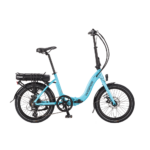I have run my Pro Connect with a 16 back cog for over 6,000 miles and when I came to replace the chain set I thought I would try out a 11 tooth motor sprocket. I have done 800 miles and after the initial getting the chain length right (thing jumps) I am very impressed. I have lost a bit of that whoosh when you set off in low gears (not a bad thing), Increased the top speed by 2 miles a hour. The best bit is the ability to use 1 gear lower and pedal faster because you still get the assist and I have not noticed much change in range.
11-tooth Motor Sprocket Pro Connect
- Thread starter Neil
- Start date
I fitted an 11-tooth motor sprocket to my Agattu too - Amazing difference - Feels like a whole different class of vehicle... but the battery life takes something of a hit.
If you ran the standard 23-tooth sprocket on the back of the Agattu, the result would be a top assist speed increased to 18.3mph.
With any other gearing setup, it's 22% higher than you would otherwise get with the 9 tooth cog on the motor.
The Panasonic unit uses the rotational speed of the motor to calculate the pedal cadence (based on the chain speed), so by changing the motor sprocket, you increase the cadence which the unit assists up to, and also increase the top assist speed. The change to an 11-tooth cog makes the whole system feel a lot racier, but a lot less sedate.
If you want to get somewhere in a hurry, then 11-tooth is great, but if you're looking to amble along then the more sedate pace of the 9-tooth is better suited.
I actually have the 9-tooth on my Agattu at the moment as I wanted a long-distance rather than high-speed setup, and everywhere is wet and slippery right now anyway.
With any other gearing setup, it's 22% higher than you would otherwise get with the 9 tooth cog on the motor.
The Panasonic unit uses the rotational speed of the motor to calculate the pedal cadence (based on the chain speed), so by changing the motor sprocket, you increase the cadence which the unit assists up to, and also increase the top assist speed. The change to an 11-tooth cog makes the whole system feel a lot racier, but a lot less sedate.
If you want to get somewhere in a hurry, then 11-tooth is great, but if you're looking to amble along then the more sedate pace of the 9-tooth is better suited.
I actually have the 9-tooth on my Agattu at the moment as I wanted a long-distance rather than high-speed setup, and everywhere is wet and slippery right now anyway.
Interesting. I have just changed my Pro Connect rear sprocket for a 19T and it now feels just right to me.
I assume that, provided the overall gear ratio works out the same, there is no effective difference to using a bigger motor sprocket rather than using a smaller rear sprocket. So, if I understand this correctly, if a smaller rear sprocket is used then a given motor rotation results in a higher speed in the same way that a larger motor sprocket does? I suspect there are the pros and cons to either method that I don't know about.
I assume that, provided the overall gear ratio works out the same, there is no effective difference to using a bigger motor sprocket rather than using a smaller rear sprocket. So, if I understand this correctly, if a smaller rear sprocket is used then a given motor rotation results in a higher speed in the same way that a larger motor sprocket does? I suspect there are the pros and cons to either method that I don't know about.
Last edited:
Yes - the main difference is that changing the motor sprocket increases the pedalling speed, rather than just the bike speed. The Panasonic system has a 4-stage power down as you approach the cutoff speed. With the 9-tooth cog, the maximum assist level is only available up to a cadence of 42. With the 11-tooth cog that is raised up to 51, so you get more assistance from the motor when you're whizzing along.I assume that, provided the overall gear ratio works out the same, there is no effective difference to using a bigger motor sprocket rather than using a smaller rear sprocket. So, if I understand this correctly, if a smaller rear sprocket is used then a given motor rotation results in a higher speed in the same way that a larger motor sprocket does? I suspect there are the pros and cons to either method that I don't know about.
The theoretical downside to changing to an 11-tooth cog is that the motor produces less torque get you up hills... however, as your legs produce more power at higher cadences, then the loss of torque from the motor is made up for by the higher pedalling speed, and also the increased cut-off speed. The net result is that you fly along on the the flat, get up hills faster, but end up putting in a bit more work on the hills too as you end up pedalling faster.
Given the low cost involved with the 11-tooth cog (£15) I'd recommend that you try one and see if you like it.
I have worked out a trick for changing the sprockets really quickly using three Torx screwdrivers as if they are chopsticks - I'll try and capture it as a video next time I have the chain guard off my bike.
Thanks Fecn. I think my changing the rear sprocket was best for me as it is help up the hills I need most.
You Run out of power
The speed is limited by the power of the motor. I have had strong head winds going to work and joy of joy strong tail winds going home. With a tail wind you get 22-23+ on the flat with not too much effort but the other way more than 18 19 is hard work against the wind. When do we get 500W motors? I do a average of to and from work (17+ miles) of about 19 mph. Changing the motor cog I got an increase of about 2mph in top speed.
The speed is limited by the power of the motor. I have had strong head winds going to work and joy of joy strong tail winds going home. With a tail wind you get 22-23+ on the flat with not too much effort but the other way more than 18 19 is hard work against the wind. When do we get 500W motors? I do a average of to and from work (17+ miles) of about 19 mph. Changing the motor cog I got an increase of about 2mph in top speed.
The maximum power (peak) of your motor is 422 watts in fact, but since it's delivery is controlled by the torque sensor and therefore the effort you put in, you would need to input a matching 422 watts to get the motor to match it in standard mode, or almost 320 watts to get the peak from the motor in high power mode.When do we get 500W motors?
It needs a top class race rider to maintain over 400 watts, and 300 watts is reckoned to be the best a fit male in their middle years could input for 5 minutes maximum when cycling. In reality most of us can't keep up anywhere near those levels. Of course the torque sensor arrangement is influenced by the Japanese market law where the unit was designed, full details on this link.
.
I have recently measured this, and recorded peaks of up to 540W with the panasonic motor. The highest motor current I saw was 17.82A, which surprised me as I thought there was a 15A limit on the system. The graph below shows a 1-mile test run when I was pushing the system as hard as I could to see just how much power I could get out of it. The scale along the bottom is seconds of time. As you can see, the system easily exceeds 350W for many tens of seconds at a time.The maximum power (peak) of your motor is 422 watts in fact....

Interstingly, with the 9-tooth cog attached, I was not able to get anywhere near the same peak power (442 watts was the highest I recorded with 9-tooth cog). I was also not able to get the extended periods above 300W as I did with the 11-tooth cog, and recorded a max-continous of around 250W as per the panasonic specs.
I will gather more data when I can. Work and weather has limited my riding for the last few weeks.
Last edited:
I agree Fecn. I use Panasonic's own figures which are realistic maximums for continuous operation without overheating, hence my first mention of "peak" placed in brackets. The short term peak will indeed be higher, and very much higher for the shortest peaks. Just a pity that the torque sensor doesn't permit a greater realisation of the capabilities for average riders.
My own Q-bike motor's maximum is a realistic 720 watts, but the peak can reach 1000. Having throttle operation I can get all of that, but what it does to the range isn't too welcome.
.
My own Q-bike motor's maximum is a realistic 720 watts, but the peak can reach 1000. Having throttle operation I can get all of that, but what it does to the range isn't too welcome.
.
Related Articles
-
 MTF Enterprises announces acquisition of EMU Electric Bikes
MTF Enterprises announces acquisition of EMU Electric Bikes- Started by: Pedelecs
-
 Wisper 806T folding bike wins Which? ‘Best Buy’
Wisper 806T folding bike wins Which? ‘Best Buy’- Started by: Pedelecs
-
 Sustrans calls for protected cycle lanes
Sustrans calls for protected cycle lanes- Started by: Pedelecs
-
 Amazon launch their first UK e-cargo micromobility hub
Amazon launch their first UK e-cargo micromobility hub- Started by: Pedelecs


